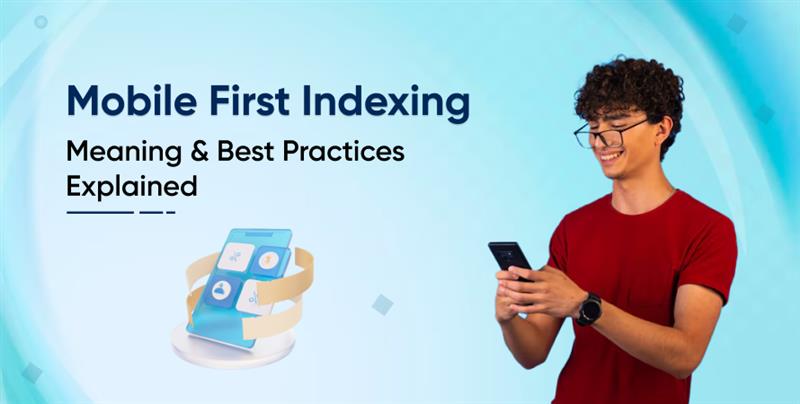Mobile-First Indexing: Meaning & Best Practices Explained



Introduction
Over the past decade, the internet has witnessed a significant shift in user behavior—more people now access websites via mobile devices than desktops. In response, Google has adapted its search algorithm to reflect this change, putting mobile usability at the core of how it indexes and ranks websites. This shift is known as mobile-first indexing.
Mobile-first indexing represents one of the most important changes in how Google interprets and serves content on the web. It affects how your site is crawled, how your content is evaluated, and ultimately how well your website performs in search engine rankings. If your business depends on organic traffic, ignoring mobile-first indexing is no longer an option—it’s a strategic necessity.
In this guide, we’ll explore what Google’s mobile-first indexing truly means, why it matters now more than ever, and how to align your digital presence with Google’s expectations. From mobile SEO best practices to mobile website optimization and avoiding common mistakes, this blog will give you the tools you need to stay ahead in a mobile-dominated web ecosystem.
What is Mobile-First Indexing?
Mobile-first indexing means that Google predominantly uses the mobile version of your website’s content for indexing and ranking. Previously, Google’s systems primarily looked at the desktop version of a site to evaluate its relevance to a user’s query. But now, with mobile-first indexing fully rolled out, it’s the mobile version that takes priority.
This shift doesn’t mean there’s a separate “mobile index” or that desktop sites are ignored. Instead, it simply means that Google’s crawlers now treat the mobile version of your content as the primary version, even for users searching on desktop.
Timeline of the Shift
Google began experimenting with mobile-first indexing in 2016 and started gradually rolling it out in 2018. By March 2021, Google confirmed that mobile-first indexing is the default for all new websites. Today, nearly all websites are evaluated from a mobile perspective.
Mobile-First vs. Mobile-Only Indexing
It’s important to distinguish between mobile-first and mobile-only indexing. Mobile-first indexing prioritizes your mobile site for crawling and ranking. But if you don’t have a mobile-friendly site, Google will still crawl your desktop version—though it may be at a disadvantage in rankings. Mobile-only indexing, on the other hand, would exclude desktop versions entirely (this is not how Google operates as of now).
Why Mobile-First Indexing Matters Today
The transition to mobile-first indexing aligns with broader trends in user behavior. More than 60% of global internet traffic now comes from mobile devices, and that number continues to grow. Users expect fast, seamless, and intuitive mobile experiences, and Google is adapting to meet that demand.
Business Implications
If your website isn’t optimized for mobile, it risks:
- Lower rankings in search results
- Poor user engagement and high bounce rates
- Missed opportunities for mobile conversions
Whether you run an e-commerce store, a service-based business, or a content-driven blog, understanding and optimizing for mobile-first indexing is essential for long-term success.
Understanding the Relationship Between Mobile-First Indexing and SEO
SEO and indexing are closely intertwined. If Google can’t properly access, crawl, or understand your content on mobile, your rankings will suffer—even if your desktop version is perfectly optimized.
Indexing Affects Ranking
With mobile-first indexing, the content on your mobile site must be as comprehensive and structured as your desktop site. Incomplete or hidden content on mobile may not get indexed or ranked. That’s why consistency across versions is a foundational element of mobile friendly SEO.
Technical SEO & Crawlability
Mobile-first indexing places greater emphasis on:
- Mobile-friendly layouts and navigation
- Correct usage of structured data
- Properly functioning internal links
- Avoiding blocked JavaScript, CSS, and media files on mobile
Neglecting these factors may prevent Google from accurately evaluating your site’s content and structure.
Mobile SEO Best Practices in the Era of Mobile-First Indexing
To ensure your site performs well in a mobile-first environment, adopt the following mobile SEO best practices:
1. Same Content Across Devices
Avoid trimming or hiding content on the mobile version of your site. All important information, including text, images, internal links, and schema markup, should be consistent between desktop and mobile.
2. Optimize Meta Tags
Ensure your mobile site includes all meta titles and descriptions. Metadata should match your desktop version to avoid inconsistencies that confuse crawlers.
3. Use Responsive Design
Google recommends responsive design over dynamic serving or separate URLs. A responsive site uses the same HTML but adjusts its layout based on the user’s screen size, offering a seamless experience across devices.
4. Structured Data for Mobile
Include the same schema markup on both mobile and desktop versions of your site. Use Google’s Rich Results Test to verify your structured data is functioning correctly on mobile.
5. Make Use of Mobile XML Sitemaps
Although not required, creating a separate mobile sitemap can help Google discover your mobile content more efficiently, especially for complex or JavaScript-heavy sites.
Core Mobile Website Optimization Tips
Mobile website optimization goes beyond design—it’s about speed, usability, accessibility, and performance on real-world devices.
1. Improve Page Load Speed
Fast-loading pages are critical for both user experience and search rankings. Focus on:
- Minimizing server response times
- Compressing images
- Using lazy loading
- Eliminating render-blocking resources
Tools like Google PageSpeed Insights and Lighthouse can help you identify and fix performance bottlenecks.
2. Prioritize Core Web Vitals
Core Web Vitals are a set of user-focused performance metrics:
- Largest Contentful Paint (LCP): Measures load speed
- First Input Delay (FID): Measures interactivity
- Cumulative Layout Shift (CLS): Measures visual stability
These metrics are especially important on mobile, where device limitations can amplify UX issues.
3. Optimize Fonts and Tap Targets
Ensure font sizes are legible on smaller screens and that buttons are easy to tap without zooming. A minimum tap target size of 48×48 pixels is recommended by Google.
4. Avoid Intrusive Interstitials
Pop-ups that block content or frustrate users can hurt your rankings. Use non-intrusive banners and ensure easy dismissal.
Mobile-Friendly SEO: What It Really Means Today
A mobile-friendly site isn’t just one that “looks good” on a phone. Mobile friendly SEO involves optimizing for both technical performance and real user behavior.
Responsive vs. Adaptive vs. Separate URLs
- Responsive design (preferred): Same URL, same content, adjusts layout
- Adaptive design: Different layouts for different screen sizes
- Separate URLs: Mobile and desktop have different URLs (e.g., m.example.com)
While all three can work with mobile-first indexing, responsive design is most efficient and SEO-friendly.
Mobile UX Matters
Good mobile UX means:
- Easy navigation via thumb-friendly menus
- Clear call-to-actions
- Simplified forms
- Mobile-optimized checkout experiences
These elements contribute directly to engagement, conversions, and SEO rankings.
Tools & Techniques to Audit Mobile Readiness
Use these tools to evaluate and improve your site’s mobile performance:
- Google Mobile-Friendly Test: Checks if your page is mobile-friendly
- Google Search Console: Mobile Usability report and coverage issues
- PageSpeed Insights: Shows performance metrics and Core Web Vitals
- Lighthouse: In-depth audits for performance, accessibility, and SEO
- Screaming Frog (mobile user-agent): For crawling and identifying mobile-specific issues
Common Mistakes to Avoid with Mobile-First Indexing
Even well-established sites fall into these traps:
- Hidden content on mobile: Collapsible text or hidden sections can prevent indexing
- Blocking resources: Don’t block CSS, JS, or image files in robots.txt
- Discrepancies in structured data: Ensure mobile schema is identical to desktop
- Slow mobile pages: A desktop-optimized site often performs poorly on mobile
- Incorrect canonical tags: Ensure proper use of canonical and alternate tags if using separate URLs
Future Trends in SEO Mobile-First Indexing
Mobile-first indexing for Google is here to stay, but its evolution continues:
- AI and mobile UX: AI-driven design tools will create hyper-personalized mobile experiences
- Voice search optimization: Mobile devices are the primary platform for voice queries
- Progressive Web Apps (PWAs): These will blur the line between websites and apps
- Increased focus on user intent and behavior signals: Google will continue to refine how it interprets mobile user experience
Conclusion
Mobile-first indexing is no longer an optional SEO consideration—it’s the foundation of how Google understands and ranks your content. Ensuring your mobile experience matches or exceeds your desktop version in content, speed, and usability is critical for maintaining search visibility.
From technical SEO alignment to real-world performance metrics, prioritizing mobile ensures you’re building for the future. Follow the mobile SEO best practices outlined here, invest in mobile website optimization, and adopt a mobile friendly SEO approach across your digital strategy.
If you’re serious about improving your site’s performance and visibility, especially in the mobile-first era, consider working with specialists who understand the intersection of user experience and performance.
Need help? Hire Core Web Vitals Consultants to unlock your website’s full mobile potential.
Frequently Asked Questions (FAQs)
Mobile-first indexing refers to Google using your mobile site for indexing and ranking. Mobile-friendly means your site is usable and accessible on mobile devices.
Yes. If your mobile version lacks content, structured data, or speed optimizations, your rankings can suffer—even if your desktop version is optimized.
Check in Google Search Console under the “Settings” tab. It will show whether mobile or desktop is being used for indexing.
Google will still index your desktop site, but you may be at a significant disadvantage in mobile search results.
Responsive design is not required but highly recommended. It ensures consistency, ease of maintenance, and alignment with Google’s best practices.